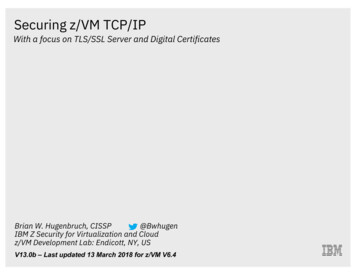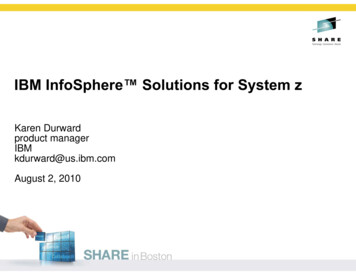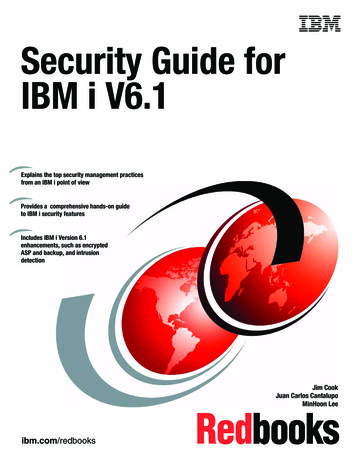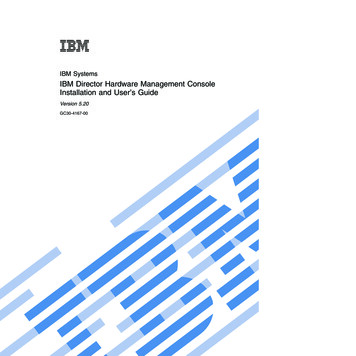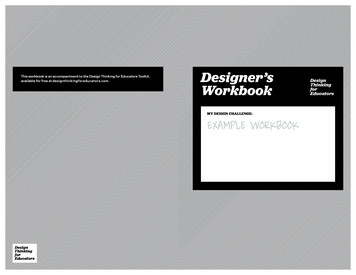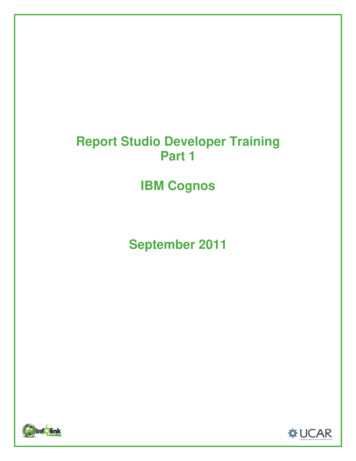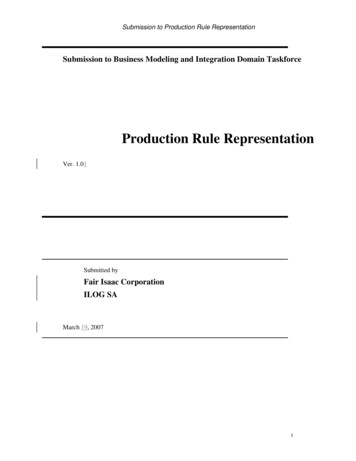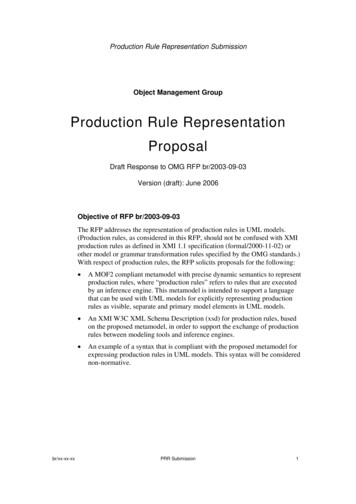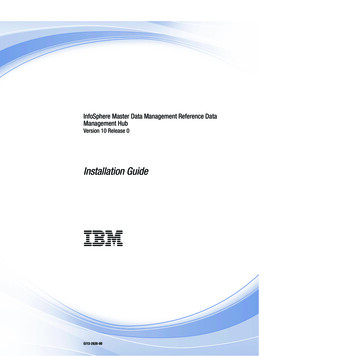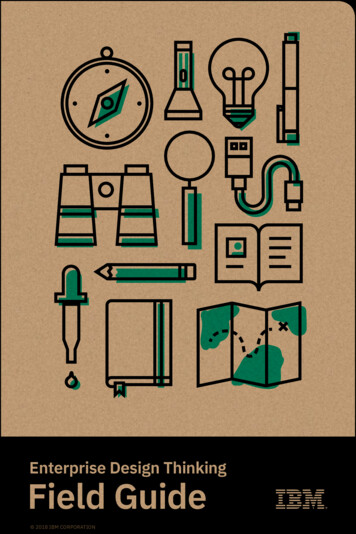
Transcription
2018 IBM CORPORATION
Human-centeredoutcomes atspeed and scaleAt IBM, we define design as the intent behind an outcome.We use design thinking to form intent by developingunderstanding and empathy for our users.Get the latest versionThis field guide is updated frequently.Anyone can download the latest version atibm.biz /fieldguide-publicIBMers can order printed copies and leavefeedback at ibm.biz /fieldguide-ibmersFROM PROBLEMS TO SOLUTIONSEnterprise Design Thinking is our approach to applyingdesign thinking at the speed and scale the modernenterprise demands. It’s a framework for teaming andaction. It helpsour teams not only form intent, but deliver outcomes—outcomes that advance the state of the art and improvethe lives of the people they serve.What’s inside?Divided into two sections, this field guide provides a high-leveloverview of Enterprise Design Thinking:LEARNING ITA summary of thefundamental conceptsof Enterprise Design Thinking 2018 IBM CORPORATION v3.5WLEADING ITA quick reference forfacilitating essentialEnterprise Design Thinkingactivities on your team 2018 IBM CORPORATION v3.5W
LEARNING ITUser-centered designDesign as a professional discipline has undergone a tremendousevolution in the last generation from a practice focused mainly onaesthetic style to one with a clear and explicit focus on the “user”(aka: person or group of people who use a product or service) andtheir hopes, desires, challenges, and needs.By establishing empathy with the user, designers are able to worktoward outcomes that meet those needs more successfully.This user-centered approach known as “design thinking” enablesdesigners and others to address a wide range of complex businessand social issues.“Designers don’t tryto search for a solution until theyhave determined the real problem, and eventhen, instead of solving that problem, they stop toconsider a wide range of potential solutions. Onlythen will they finally converge upon their proposal.This process is called design thinking.”—Don Norman,author, The Design of Everyday ThingsEnterprise Design Thinking:The PrinciplesSEE PROBLEMS AND SOLUTIONS FROM A NEW POINT OF VIEWBefore you start your journey, embrace the principles of EnterpriseDesign Thinking: a focus on user outcomes, diverse empoweredteams, and a spirit of restless reinvention.A FOCUS ON USER OUTCOMESOur users rely on our solutions to get their jobs doneeveryday. Success isn’t measured by the featuresand functions we ship—it’s measured by how wellwe fulfill our users’ needs.DIVERSE EMPOWERED TEAMSDiverse teams generate more ideas than homogeneous ones, increasing your chance of a breakthrough.Empower them with the expertise and authority toturn those ideas into outcomes.RESTLESS REINVENTIONEverything is a prototype. Everything—even in-marketsolutions. When you think of everything as just another iteration, you’re empowered to bring new thinkingto even the oldest problems.Learn moreLearn more about the Principles at ibm.biz/ThePrinciples2 2018 IBM CORPORATION v3.5W 2018 IBM CORPORATION v3.5W
LEARNING ITEnterprise Design Thinking:The LoopEnterprise Design Thinking:The KeysUNDERSTAND USERS’ NEEDS AND DELIVEROUTCOMES CONTINUOUSLYAt the heart of Enterprise Design Thinking is a behavioral modelfor understanding users’ needs and envisioning a better future:a continuous loop of observing, reflecting, and making.SCALE YOUR PRACTICE TO COMPLEX PROBLEMSAND COMPLEX TEAMSIf every problem could be solved by a handful of people, the Loopwould be enough. But in the real world, complex problems call forcomplex teams.HILLSAlign complex teams around a common understandingof the most important user outcomes to achieve.PLAYBACKSBring your extended team and stakeholders into theloop in a safe, inclusive space to reflect on the work.OBSERVEImmerse yourself inthe real world to getto know your users,uncover needs, learnthe landscape,and test ideas.REFLECTCome together andform a point of viewto find commonground, align theteam, uncoverinsights, and planahead.MAKEGive concrete formto abstract ideas toexplore possibilities,communicate ideas,prototype concepts,and drive realoutcomes.SPONSOR USERSCollaborate with real users to increase your speedand close the gap between your assumptions andyour users’ reality.Learn moreSee the Keys in action here: ibm.biz/TheKeys4 2018 IBM CORPORATION v3.5W 2018 IBM CORPORATION v3.5W
LEARNING ITGet alignedHillsAlign complex teams around acommon understanding of the mostimportant user outcomes to achieve.A SAMPLE HILLWHOState your intent: Hills turn users’ needs into project goals, helpingyour team align around a common understanding of the intendedoutcomes to achieve.TAKE-BACK TIPSWho, What, Wow! Hills are composed of a “Who” (a specific useror group of users), a “What” (a specific action or enablement), anda “Wow” (a measurable, market differentiator).Three and only three. It’s often challenging for teams to focus onthree (and only three) Hills because this might mean that very validideas are not being included. It’s important to realize that additionalHills can be addressed in future releases. Consider building theminto a roadmap.It’s a real world out there. We know there’s a backlog to groomand technical debt to pay down. Your investment in necessary itemslike these—the “technical foundation”—should be made explicitup front while defining your Hills.WHATWOWLearn moreLearn how to write a user-centered Hill:ibm.biz/WriteHills6 2018 IBM CORPORATION v3.5W 2018 IBM CORPORATION v3.5W
LEARNING ITStay alignedNot everyone has time to be in the loop on every project. Dependingon your perspective, over time, it might seem like the project isdrifting off-course, or that your stakeholders are out of touch withwhat your team has learned.PlaybacksTAKE-BACK TIPSReflect together in a safe space togive and receive criticism.No surprises! Leading up to milestone Playbacks, hold meetingsand working sessions with all necessary stakeholders to gainconsensus and share work-in-progress along the way.Show before you tell. Playback decks should have a strongly visualemphasis based on the work—not contrived synopses or feel-goodscenarios.COMMON TYPES OF MILESTONE PLAYBACKSMARKET PLAYBACK establishesan outside-in market point of viewand preliminary business caseas the basis for moving forward.PLAYBACK ZERO aligns your teamaround a finalized version of theHills and the user experience toachieve them.HILLS PLAYBACK commitsyour team to the mission for therelease(s) through a draftversion of the Hills and theunderlying personas.DELIVERY PLAYBACKS of codedstories keep your to-be scenariosinfocus as implementation advances.Make us care. A real, human story should be at the core of everyPlayback. Show how your tool or concept solves a problem inyour user’s real world workflow.Learn moreGet insights on how to conduct a great Playback:ibm.biz/TeamPlaybacks8 2018 IBM CORPORATION v3.5W 2018 IBM CORPORATION v3.5W
LEARNING ITBreak the empathy barrierSponsor UsersGive users a seat at the table.Invite them to observe, reflect,and make with you.Sponsor Users are users or potential users that bring their livedexperience and domain expertise to your team. They aren’t justpassive subjects—they’re active participants who work alongsideyour team to help you deliver an outcome that meets their needs.While Sponsor Users won’t replace formal design research andusability studies, every interaction you have together will close thegap between your assumptions and their reality.TAKE-BACK TIPSDesign for real target users rather than imagined needs.Sponsor Users should be real people, not personas or “types.”They participate with your team during the entire developmentprocess under Agreements.Sponsor Users should attend Playbacks. Ideally, a Sponsor Usercan actually present the product demo during your Playback Zero.Involve your whole team. Finding Sponsor Users is not theresponsibility of a single person or discipline—everyone on yourteam should be contributing ideas for Sponsor Users.Learn moreEnable you and your team to work withSponsor Users: ibm.biz/SponsorUsersPotential users are all around us. You can find users in surprisingplaces like conferences, meetups, and through social media. Butwhen engaging Sponsor Users, be sure to follow secure and ethicalpractices and maintain compliance with all IBM policies.10 2018 IBM CORPORATION v3.5W 2018 IBM CORPORATION v3.5W
LEARNING ITExperience matters.Whether we design for them or not, our products and servicesare framed by universal experiences. Each experience offersopportunities to solve unmet needs and emotionally bond people toour products and experiences, or offerings. When someone is “trying”your offering, they should create value just as if they were “using” it.Take your user to heart.The people we serve’s, or our users’, worlds are inevitably morecomplicated than what’s observable on the surface. Zoom out. Striveto understand their end-to-end experience, what you’re asking themto do, and the impact it will have. In enterprise business, processbased dependencies often impact the user. We must be authenticallythoughtful in our design of an experience, and respect what a userneeds from across all experiences.Design a vaseDesign abetter wayfor people toenjoy flowersTAKE-BACK TIPSWhat’s next? Someone’s ideal experience this year won’t betheir ideal experience next year. Anticipate overhaul.Break the mold. Don’t feel confined to the structures andprocesses you currently work in.Glue it all together. Define experiences to help organizedispersed teams (including sales, support, and marketing)around user-focused outcomes.Learn moreThere’s lots more about experiences onthe IBM Design Language website:ibm.com/design/language12 2018 IBM CORPORATION v3.5W 2018 IBM CORPORATION v3.5W
LEARNING ITRadical collaborationRadical collaboration“Radical collaboration” means that all key stakeholders are part ofco-creating great user experiences from the beginning. For yourteam to take full advantage of Enterprise Design Thinking, you needto commit to a cross-discipline way of working throughoutthe entirety of a release.USER rganizationKeep in mind: when teams fail, it’s not usually because they didn’thave great ideas. It’s probably because they didn’t include the peoplewho had them. Radical collaboration is about proactively includingdiverse perspectives and disciplines in our conversations—see theprinciple of “diverse empowered teams” on page 3. When you’re notsure who to invite to a conversation, err on the side of inclusivity.TAKE-BACK TIPSGood collaboration needs good communication. As your teamstarts to work together, come to agreement on a set of expectationsand a system for communicating with each other. Create a “tool chain”of collaboration tools that lets stakeholders share their work-inprogress while they work day-to-day in the tools that best fit their role.Don’t slip back into the waterfall. If you start to find your teamsimply reviewing artifacts after-the-fact with stakeholders fromother disciplines: STOP AND START OVER with broad, up-front, andactive participation in their creation.BUSINESSOffering ManagementOrganizationN-in-a-box. Whenever possible, go beyond “3-in-box” (design,engineering, and offering management) to include other disciplinessuch as content design, sales, marketing, and support in design thinkingactivities, key decisions, workshops, and milestone Playbacks.14 2018 IBM CORPORATION v3.5W 2018 IBM CORPORATION v3.5W
LEARNING ITIBM Offering ManagementIBM Offering Management is IBM’s point-of-view on markets, users,products, and services. Offering managers decide in which marketsIBM will play and how we will differentiate in those markets viaunique functionality, great user experiences, digital engagement,and ecosystem partnering.Offering managers are empowered to act as entrepreneurs toexplore new markets of users with new user experiences. They areresponsible for leading the co-creation of “whole” offerings thatdeliver value across all of the six universal experiences.StrategicPlanningand PortfolioManagementMarket Opportunityand ApproachDefine andProveMeasure andEvaluateTAKE-BACK TIPSGet outside. Great offering managers “get out of the building” todiscover real user experiences to improve upon. User, market, andcompetitive research provide the fact base for all offering decisions.Build andDeliverLook across offerings. Given IBM’s comprehensive portfolios,offering managers should look at how individual offerings worktogether to address users in a market. Most of our offerings will bepart of larger solutions.Lead your offering. Offering managers are being empowered to leadtheir offerings, but no one is going to clear the path for you. It’s upto each offering manager to act as an internal entrepreneur for theiroffering—their key “superpower” will be persuasion, not command.Ch-ch-changes. At IBM, the practice of Product Managementis evolving into Offering Management to ensure that IBM wins inmarkets with iconic user experiences and an integrated point-ofview that is differentiated from competitors.16 2018 IBM CORPORATION v3.5W 2018 IBM CORPORATION v3.5W
LEARNING ITLearn moreAgile andEnterprise Design ThinkingThere’s a great deal of shared “DNA” between Agile and EnterpriseDesign Thinking: individuals and interactions over processes andtools, working prototypes over comprehensive artifacts, customercollaboration over contract negotiation, and pivoting for changeover sticking to the original plan. Enterprise Design Thinking helpsyou discover what problem to solve, while Agile helps you plan howto solve it. What links them most closely is the continuous cycle ofexperience maps and Playbacks.IBMers can learn moreat Agile Academy:ibm.biz/AgileAcademyIBM Agile AcademyprinciplesIteration &learningRestlessreinventionSelf-directedwhole teamsTAKE-BACK TIPSHypothesis-driven design and development. Create measurablehypotheses describing what you think success looks like and theninvestigate and possibly pivot when reality doesn’t meet yourexpectation—positively or negatively.DiverseempoweredteamsClarity ofoutcomesFocus onuser outcomesEnterprise DesignThinkingprinciplesEveryone grooms the backlog. Leaders from each disciplineregularly meet to groom the backlog, updating the priority asnecessary and ensuring that the top of the backlog represents currentpriorities and stays true to the “minimum delightful experience.”Double-vision. When people across disciplines see the backlogthrough the dual lenses of functionality and experience, then Agileand Enterprise Design Thinking are truly one.Together forever. The principles of Agile and Enterprise Design Thinkingare very closely aligned. Together, they offer an opportunity to solvecomplex problems for our users with creativity and empirical adaptation.18 2018 IBM CORPORATION v3.5W 2018 IBM CORPORATION v3.5W
LEARNING ITIn addition to this field guide, you can sign up for access to moreonline learning and resources at ibm.com/design/thinking. There,you will find comprehensive courses designed to help you take thenext step in your design thinking journey and work toward yourEnterprise Design Thinking certification. With an account, you willalso gain access to a full, digital library of the activities in this guide.DIGITAL EXPERIENCEEnterpriseDesign ThinkingEducationAccess online educational resourcesdesigned to help you practice designthinking today.Expert training from experienced design thinkers. Dive intothe framework and uncover the value of design thinking through acomprehensive online training program, and unlock the tools thatyou need to practice it in your day-to-day.A guided journey with intentional milestones. Track individualand team progress through the official Enterprise Design Thinkingbadging program.Learn moreIndividuals and teams can begin a free trial of theonline learning by visiting: ibm.com/design/thinking20 2018 IBM CORPORATION v3.5W
LEADING ITMantrasof theMaster FacilitatorLESS TALKING, MORE WRITINGEveryone should capture lots of ideas onto sticky notesand post them on the wall before discussing them.LESS WRITING, MORE DRAWINGDifferent words mean different things to different people. Instead,try making a quick or crude sketch to communicate your idea.QUANTITY OVER QUALITYIdeas with big potential can be killed easily bynegative attitudes, so first get lots of ideas postedto the wall and then discuss and distill.MAKE EVERY VOICE HEARDEveryone has a Sharpie . Everyone has a pad of sticky notes.Everyone contributes ideas. Everyone’s ideas are valid.INCLUSIVE, WHOLE-TEAM APPROACHDon’t make decisions without involving people thatwill act on them. Everyone pitches in to fill the gaps!YES, AND It’s easy to play the devil’s advocate. Instead,push yourself to build on your teammates’ ideasby saying, “Yes, and ” while iterating.BE HONEST ABOUT WHAT YOU (DON’T) KNOWSometimes you won’t have all of the answers—that’sokay! Actively work to admit and resolve uncertainty,especially on topics that put your project most at risk.ActivitiesThis section of the field guide contains activities for your team to useevery day to help you practice radical collaboration and put the userat the center of your project. Each activity can be used in isolationor as part of a broader set of activities with your team and SponsorUsers. Think of each activity as a tool that helps you establish theEnterprise Design Thinking framework, understand your user’sproblems and motivations, explore new concepts, prototypedesigns, and evaluate with stakeholders.Remember, this is not a cookbook or a set of recipes. Nor is it aprocess or methodology. It’s a set of recommended practices that willhelp you think orthogonally and move beyond feature-centric delivery.TAKE-BACK TIPSSpace and supplies. Prepare your workspace with pads of stickynotes of various colors, some Sharpie markers, and a drawingsurface—a whiteboard or large pad will do. These tools encourageevery team member to engage in the thinking behind the design.If your team is distributed, there are plenty of virtual substitutes—see page 20.Conversations and collective decisions. The activitiescontained here are intended to encourage focused and productiveconversations between multiple disciplines on your team. Thevalue isn’t in having a completed artifact—it’s in doing the activitiestogether so that you can agree on the right course of action together.If you’re sitting down, you’re having a meeting. Get everyone upand active—it’s difficult to include many voices when one person isstanding at the front of the room. If you have lots of participants,break them up into working groups of 5–8 people and frequentlyplayback to each other. 2018 IBM CORPORATION v3.5W
LEADING ITDesign thinking facilitationDesign thinking facilitators initiate and lead design thinking activitieson their team to reach great outcomes for their users. With time andpractice, anyone can become an effective and credible facilitator.FACILITATION IS AN EVERY DAY PRACTICE.Do you find yourself doing these things on a regularbasis? If so, you’re a natural facilitator!GREAT FACILITATORS Whether facilitating an ad hoc activity to help your team workthrough an immediate decision or planning a lengthier and moreformal workshop, use what works for you. Enterprise DesignThinking is designed as a framework for you and your team to usebits and pieces of as it makes sense.As a design thinking facilitator, you help ensure that conversationsand activities are centered on the user, how they work, and whatmarket they occupy. And you can serve as the driving force forinclusion and collaboration so the voices of people from all areasof your business are heard and understood.TAKE-BACK TIPSPractice makes perfect. Much like practicing Enterprise DesignThinking in general, we find that the best facilitators learn to be betterfacilitators by doing facilitation. Continued weekly practice over time,matched with coaching or apprenticeship, will prepare you to leadmore advanced design thinking engagements like workshops.Use what works for you. Concentrate your facilitation efforts oninitiating design thinking activities that make sense for the work yourteam is doing right now and guiding those teammates who aren’tfamiliar with design thinking by actively engaging them in the practices.Plan, communicate, and lead design thinkingactivities, whether formal or informal.Have a passion and enthusiasm for getting thewhole team involved.Guide coworkers in understanding andproductively engaging in design thinking activities.Drive the process and guide to the goal, but don’tdefine the details of the end result.Ensure shared understanding and have everyone’svoice heard.Know what their limits are and can say, “That’sa great question! I don’t know the answer butI know someone who does.”Learn moreIBMers can learn much more about facilitation andworkshop planning in the Enterprise Design ThinkingFacilitator Handbook: ibm.biz/facilitator-handbook24 2018 IBM CORPORATION v3.5W 2018 IBM CORPORATION v3.5W
LEADING ITHopes and FearsWHEN YOU MIGHT USE THISTIMEIf you’re starting a project, kicking-off a workshop,or bringing in new team members, this activity helpsyou get to know each other, expose aspirations andconcerns, and prepare everyone to start.15–30minutesINSTRUCTIONS1. Label one area for Hopes and another for Fears.2. Ask team members, “What about this project are you reallyexcited about? What has potential? And what are you concernedabout? What do you think won’t work?”3. Diverge, with each team member writing one “hope” or “fear” persticky note and applying it to the appropriate area on the map.4. Playback, discuss, and synthesize. What themes emerge?TAKE-BACK TIPSWarm up and take the temperature. This activity is an effectiveway to gauge participants’ attitudes about a workshop. “Hopes”usually reveal their expectations about what can be accomplishedand “fears” may reveal their doubts about making an investment towork together.26 2018 IBM CORPORATION v3.5W 2018 IBM CORPORATION v3.5WLet it persist. Keep the artifact posted where team members cansee it and refer back frequently to track progress. Place stars on“hopes” notes that become realized and remove “fears” notes thatmelt away. “Fears” that persist should be directly addressed.
LEADING ITStakeholder MapWHEN YOU MIGHT USE THISTIMEIf you’re integrating new team members, starting anew project, exploring a new market, or expandingan offering, this activity helps you identify projectstakeholders, their expectations, and relationships.30–60minutesINSTRUCTIONS1. Diverge on identifying stakeholders, one per sticky note.“Stakeholders” can include teams, team roles, project leads,executives, partners, customers, and end users.2. For each stakeholder, add a second sticky note with a quoteexpressing their thoughts, opinions, or expectations.3. In parallel, cluster stakeholders and label the groups.4. Draw and label lines among groups representing relationshipssuch as influence, process, or dependencies.TAKE-BACK TIPSDon’t delay. Take an inventory of a project’s stakeholders as soonas possible in the development cycle. It’s difficult to circle back withthose who have been forgotten, so it’s better to get a jump start thanto play catch-up.28 2018 IBM CORPORATION v3.5W 2018 IBM CORPORATION v3.5WAssumptions aren’t always bad. Assume that everyone is involvedor impacted until proven otherwise. This might seem hard to do, butit’s actually easier than trying to guess who’s impacted and riskingan accidental oversight.
LEADING ITEmpathy MapWHEN YOU MIGHT USE THISTIMEEmpathy Maps help to rapidly put your team in theuser’s shoes and align on pains and gains—whetherat the beginning of a project or mid-stream whenyou need to re-focus on your user.30–60minutesINSTRUCTIONS1. Draw the map and its four quadrants: Says, Does, Thinks, and Feels.2. Sketch your user in the center and give them a name and a bit ofdescription about who they are or what they do.3. Diverge, with each team member writing one observation persticky note and applying it to the appropriate quadrant of the map.4. Annotate unknowns (assumptions and questions) for laterinquiry or validation.5. Discuss observations and fill in gaps collaboratively.TAKE-BACK TIPSDon’t go it alone. Empathy for users arises from sharing inthe collaborative making of the Empathy Map. Everyone knowssomething about your user, so use the activity as a means to gather,socialize, and synthesize that information together.Go beyond the job title. Rather than focusing on your user’s “jobtitle,” consider their actual tasks, motivations, goals, and obstacles.30 2018 IBM CORPORATION v3.5W 2018 IBM CORPORATION v3.5WInvolve your users. Share your Empathy Maps with your SponsorUsers to validate or invalidate your observations and assumptions.Better yet, invite them to co-create the artifact with your team.
LEADING ITScenario Map(As-is / To-be)WHEN YOU MIGHT USE THISTIMEAs-is Scenario Maps help to document collectiveunderstanding of user workflows and are bestused as precursors to exploring new ideas. To-beScenario Maps tell the story of a better experiencefor your user.60–90minutesINSTRUCTIONS1. Draw four rows and label each: Phases, Doing, Thinking, and Feeling.2. Fill in the phases, one per sticky note. Don’t worry about whatthe “next phase” is; iterate through the scenario at increasingresolution until you are comfortable with the level of detail.3. In parallel, team members should begin annotating each columnwith what the user is doing, thinking, and feeling.4. Label unknowns (assumptions and questions) for later inquiryor validation.TAKE-BACK TIPSIt’s not about the interface. Rather than focusing on the user’spathway through a product’s user interface, pay close attention to thejob tasks they actually perform in order to accomplish their goals.Check your math. The solutions presented in a To-be ScenarioMap should ideally be correlated to the “pain points” identifiedin the As-is.32 2018 IBM CORPORATION v3.5W 2018 IBM CORPORATION v3.5WWarts and all. When creating the As-is Scenario Map, it’s important toarticulate your user’s actual current experience—don’t neglect tasks orqualities that are not ideal or positive. Be honest and thorough.
LEADING ITBig Idea VignettesWHEN YOU MIGHT USE THISOnce your team has a clear and validatedunderstanding of your user’s problems andchallenges, this activity is a great way formany people to rapidly brainstorm a breadthof possible ideas.TIME30–60minutesINSTRUCTIONS1. On one sticky note, write a brief overview of an idea or solution.Try labeling it with a one- or two-word headline.2. On a second sticky note, sketch a visual depiction. Think of thisas a single frame of a storyboard—for example, a rough prototypeof a user interface or depiction of a user.3. Diverge on many of these pairs of sticky notes (called“vignettes”) and quickly share them with your teammates.4. Cluster similar ideas and converge on a set that you would like totake deeper using Scenario Maps or Storyboarding.TAKE-BACK TIPSSay yes to the mess. Avoid evaluating or dismissing ideaswhile you’re generating them—dedicate a period of time to geteveryone’s thoughts onto the wall and only then begin to discusswhat’s been shared.Stay out of the weeds. Evaluate which ideas are important andfeasible (using a Prioritization Grid) before deep-diving into the details.34 2018 IBM CORPORATION v3.5W 2018 IBM CORPORATION v3.5WEveryone has ideas. Don’t make the mistake of leaving ideageneration only to the designers, the engineers, the offering managers,or the executives. Everyone has a unique perspective on the user andthe problem, so everyone should contribute ideas for solutions!
LEADING ITPrioritization GridWHEN YOU MIGHT USE THISTIMEWhen many items (such as ideas, Hills, scenarios,or user stories) are being considered, this activityhelps your team evaluate and prioritize them byfocusing discussions on importance and feasibility.30–90minutesINSTRUCTIONS1. Draw two axes: Importance to the user (low to high) andFeasibility for us (difficult to easy).2. Evaluate each item quickly and on your own—roughly plot themon the grid where they make most sense.3. Once many items are on the grid, begin to discuss with yourteammates and reposition them in relation to each other—docertain ideas seem more important or less feasible than others?4. Avoid spending too much time discussing items that fall into the“unwise” zone unless you believe they have been mis-categorized.TAKE-BACK TIPSImportance is important. Avoid considering only what is feasible,rather than what is feasible and what will have an important andmarket-differentiating impact for the user.No-brainers are everywhere. Your competitors will also be focused onthe things that are highly important and feasible. (Why wouldn’t they?They’re impactful and easy.) Instead, focus your discussion on making“utilities” more impactful and on making “big bets” more feasible.36 2018 IBM CORPORATION v3.5W 2018 IBM CORPORATION v3.5WFeasibility is more than the tech. In addition to the technicalperspective, feasibility also includes elements such as yourgo-to-market strategy and your head-count capacity to deliver.
LEADING ITNeeds StatementsWHEN YOU MIGHT USE THISTIMEThis is a very effective activity to use with yourteam when you feel that you’re drifting away fromthe actual needs, desires, and goals of your user. Ithelps reorient or reframe the work around your user.30–60minutesINSTRUCTIONS1. Write the statement: The user needs a way to do something thataddresses their need so that they benefit directly .2. Focus on your user’s pain points—this helps get at what theunderlying problems are. More than one Needs Statement cancome from a single pain point.3. Stay away from listing individual features. Instead, ask yourself,“What does my user really seek? What does she really want?”4. Cluster similar ideas
Design Thinking: a focus on user outcomes, diverse empowered teams, and a spirit of restless reinvention. Learn more . emphasis based on the work—not contrived synopses or feel-good scenarios. Make us care. A real, human story should be at the core of every Pl


